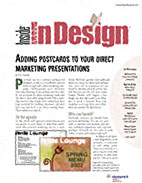The Creative Type: Making Headline Graphics in InDesign

Creativepro.com readers can subscribe to Element K Journals at a discount. Click here to learn more.
Laying out a feature article gives you the opportunity to really get creative with the headline. Rather than just formatting it with an ordinary typeface and sticking it on the page, you can incorporate the headline into the story, as shown in Figure 1. Doing this makes the headline earn its space by pulling double duty as a graphic element in the overall page layout, as well as functioning as an introduction to the article.

Figure 1: In a feature story, the headline can be worked in as part of the overall page design.
Get It in Writing
There are as many ways to graphically enhance headlines as there are feature stories. To give you an idea of the many tools InDesign provides you with to facilitate your creativity, we’ve come up with a few ideas for headlines. In this article, we’ll show you three headlines and how we created them. If you follow along, you’ll learn all sorts of things, such as how to use the Free Transform tool, insert images into text converted to outlines, and use the Compound Path command to split paths.
Transforming Your Text
One way you can get creative with a headline is to transform the text so that it adds to the message visually, such as the headline shown in Figure 2. We arranged the text so that it took on the appearance of a face and formed one word into the shape of a smile.

Figure 2: The Free Transform tool enables you to reshape text that’s been converted to paths.
To create the effect we applied to the word cavities, first type a word and format it. Always format your text before applying the Create Outlines command. Once you convert text to paths, you can resize it as you would a graphic, but you can’t edit its paragraph and character attributes. Now select the text frame with the Selection tool. Next, choose Type > Create Outlines to convert the text to a path. With the text frame still selected, choose Object > Compound Paths > Release to split the path into individual paths. This enables you to manipulate each character separately.
Tip: When you apply the Compound Path command to text converted to outlines, the closed paths of some characters, such as a, e and o, become nontransparent. To fix this, click on an anchor point of the closed path with the Direct Selection tool and then choose Object > Reverse Path.



The front part of the lesson for the word Cavities does show how to use ID’s Free Transform tool, but even for the short word in this example, the exercise is too time consuming.
The effect of enveloping text into the smile shape would be much more easily done, and with better control, if Illustrator’s or Freehand’s enveloping were used. By the time the InDesign user had finished drawing the baseline and manipulated the first two letters, the person using Illustrator or FreeHand would be done.
From that point it is a simple matter to copy and paste from those applications into InDesign. Illustrator users need to make sure the AICB is checked with Preserve Paths. FreeHand users need to choose Adobe Illustrator and Photoshop 4/5 for colors. (There is a color shift from FreeHand to InDesign, but the paths remain perfect.)
The other parts of the article are excellent, I especially like the use of compound paths to automatically reverse type as it passes over another element.